Research Methodology on Road Safety and Accidents Analysis
VerifiedAdded on 2023/04/17
|9
|1955
|230
Report
AI Summary
This report presents a research methodology on road safety and accidents, drawing from various scholarly articles. It begins with an introduction highlighting the global impact of road accidents, including the significant loss of life, injuries, and economic costs. The report emphasizes the need for comprehensive government action involving multiple sectors to address road safety. The core of the report is an annotated bibliography summarizing key articles. These articles cover diverse aspects, such as the imbalance between road demand and supply in Indonesia, the impact of motorbikes on accidents, evidence-based road safety management, cybernetic modeling in traffic safety, conceptual approaches to equipment reliability, worldwide perspectives on road safety, spatial and time simulation of traffic safety, potential for enhancing traffic safety in Russia, the impact of road improvements in Kenya, and road safety audits. Each summary provides insights into the research methodologies, findings, and recommendations of the respective studies, offering a broad overview of current research in the field.
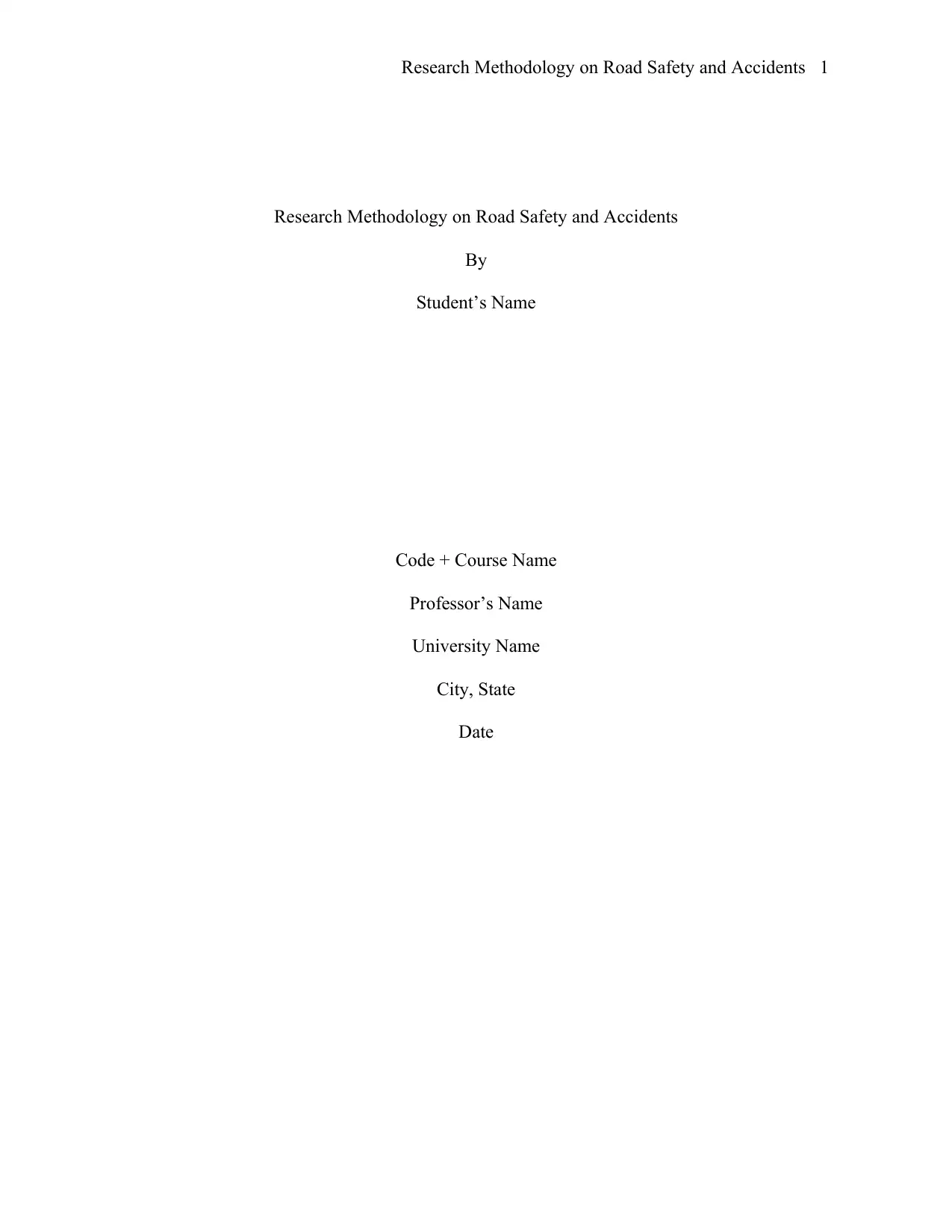
Research Methodology on Road Safety and Accidents 1
Research Methodology on Road Safety and Accidents
By
Student’s Name
Code + Course Name
Professor’s Name
University Name
City, State
Date
Research Methodology on Road Safety and Accidents
By
Student’s Name
Code + Course Name
Professor’s Name
University Name
City, State
Date
Paraphrase This Document
Need a fresh take? Get an instant paraphrase of this document with our AI Paraphraser
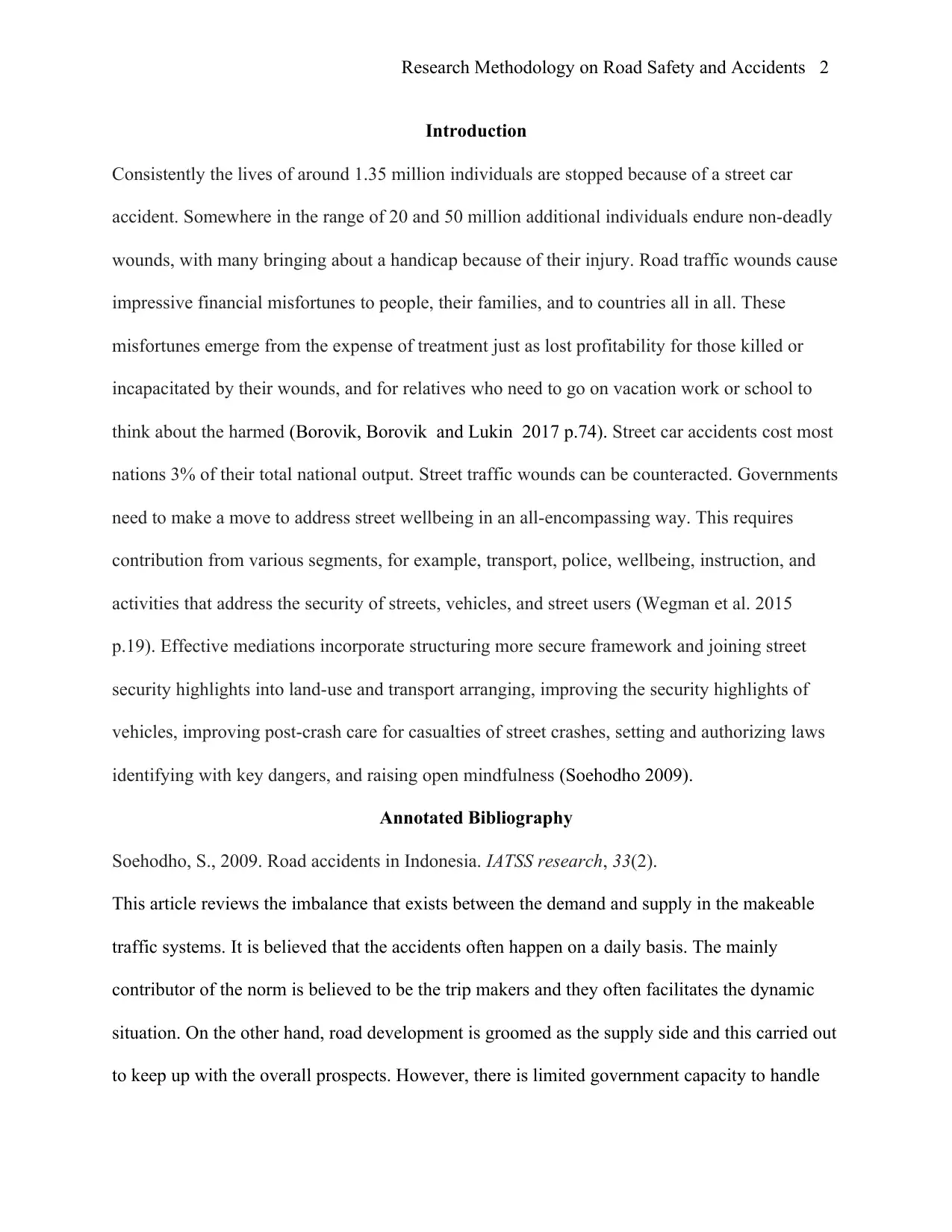
Research Methodology on Road Safety and Accidents 2
Introduction
Consistently the lives of around 1.35 million individuals are stopped because of a street car
accident. Somewhere in the range of 20 and 50 million additional individuals endure non-deadly
wounds, with many bringing about a handicap because of their injury. Road traffic wounds cause
impressive financial misfortunes to people, their families, and to countries all in all. These
misfortunes emerge from the expense of treatment just as lost profitability for those killed or
incapacitated by their wounds, and for relatives who need to go on vacation work or school to
think about the harmed (Borovik, Borovik and Lukin 2017 p.74). Street car accidents cost most
nations 3% of their total national output. Street traffic wounds can be counteracted. Governments
need to make a move to address street wellbeing in an all-encompassing way. This requires
contribution from various segments, for example, transport, police, wellbeing, instruction, and
activities that address the security of streets, vehicles, and street users (Wegman et al. 2015
p.19). Effective mediations incorporate structuring more secure framework and joining street
security highlights into land-use and transport arranging, improving the security highlights of
vehicles, improving post-crash care for casualties of street crashes, setting and authorizing laws
identifying with key dangers, and raising open mindfulness (Soehodho 2009).
Annotated Bibliography
Soehodho, S., 2009. Road accidents in Indonesia. IATSS research, 33(2).
This article reviews the imbalance that exists between the demand and supply in the makeable
traffic systems. It is believed that the accidents often happen on a daily basis. The mainly
contributor of the norm is believed to be the trip makers and they often facilitates the dynamic
situation. On the other hand, road development is groomed as the supply side and this carried out
to keep up with the overall prospects. However, there is limited government capacity to handle
Introduction
Consistently the lives of around 1.35 million individuals are stopped because of a street car
accident. Somewhere in the range of 20 and 50 million additional individuals endure non-deadly
wounds, with many bringing about a handicap because of their injury. Road traffic wounds cause
impressive financial misfortunes to people, their families, and to countries all in all. These
misfortunes emerge from the expense of treatment just as lost profitability for those killed or
incapacitated by their wounds, and for relatives who need to go on vacation work or school to
think about the harmed (Borovik, Borovik and Lukin 2017 p.74). Street car accidents cost most
nations 3% of their total national output. Street traffic wounds can be counteracted. Governments
need to make a move to address street wellbeing in an all-encompassing way. This requires
contribution from various segments, for example, transport, police, wellbeing, instruction, and
activities that address the security of streets, vehicles, and street users (Wegman et al. 2015
p.19). Effective mediations incorporate structuring more secure framework and joining street
security highlights into land-use and transport arranging, improving the security highlights of
vehicles, improving post-crash care for casualties of street crashes, setting and authorizing laws
identifying with key dangers, and raising open mindfulness (Soehodho 2009).
Annotated Bibliography
Soehodho, S., 2009. Road accidents in Indonesia. IATSS research, 33(2).
This article reviews the imbalance that exists between the demand and supply in the makeable
traffic systems. It is believed that the accidents often happen on a daily basis. The mainly
contributor of the norm is believed to be the trip makers and they often facilitates the dynamic
situation. On the other hand, road development is groomed as the supply side and this carried out
to keep up with the overall prospects. However, there is limited government capacity to handle
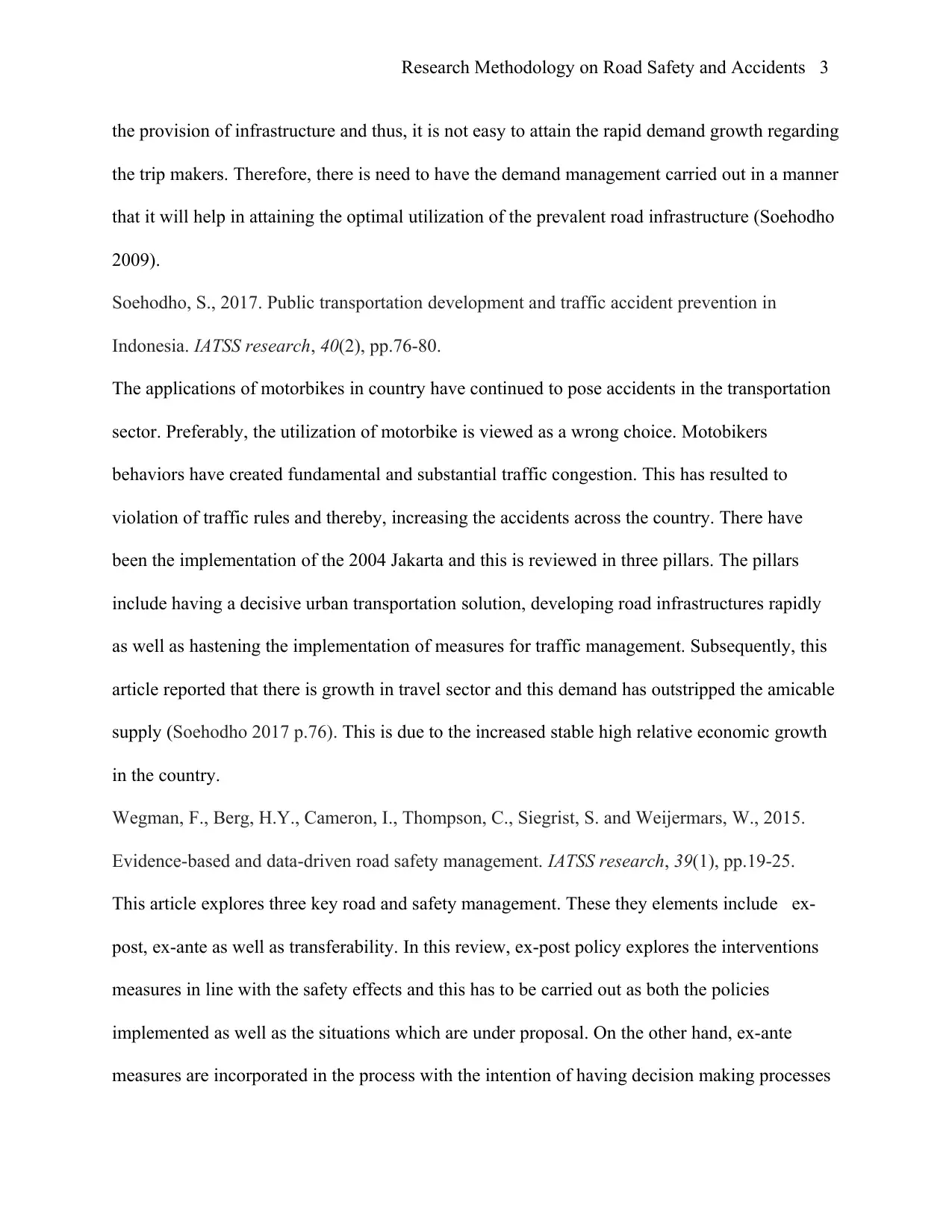
Research Methodology on Road Safety and Accidents 3
the provision of infrastructure and thus, it is not easy to attain the rapid demand growth regarding
the trip makers. Therefore, there is need to have the demand management carried out in a manner
that it will help in attaining the optimal utilization of the prevalent road infrastructure (Soehodho
2009).
Soehodho, S., 2017. Public transportation development and traffic accident prevention in
Indonesia. IATSS research, 40(2), pp.76-80.
The applications of motorbikes in country have continued to pose accidents in the transportation
sector. Preferably, the utilization of motorbike is viewed as a wrong choice. Motobikers
behaviors have created fundamental and substantial traffic congestion. This has resulted to
violation of traffic rules and thereby, increasing the accidents across the country. There have
been the implementation of the 2004 Jakarta and this is reviewed in three pillars. The pillars
include having a decisive urban transportation solution, developing road infrastructures rapidly
as well as hastening the implementation of measures for traffic management. Subsequently, this
article reported that there is growth in travel sector and this demand has outstripped the amicable
supply (Soehodho 2017 p.76). This is due to the increased stable high relative economic growth
in the country.
Wegman, F., Berg, H.Y., Cameron, I., Thompson, C., Siegrist, S. and Weijermars, W., 2015.
Evidence-based and data-driven road safety management. IATSS research, 39(1), pp.19-25.
This article explores three key road and safety management. These they elements include ex-
post, ex-ante as well as transferability. In this review, ex-post policy explores the interventions
measures in line with the safety effects and this has to be carried out as both the policies
implemented as well as the situations which are under proposal. On the other hand, ex-ante
measures are incorporated in the process with the intention of having decision making processes
the provision of infrastructure and thus, it is not easy to attain the rapid demand growth regarding
the trip makers. Therefore, there is need to have the demand management carried out in a manner
that it will help in attaining the optimal utilization of the prevalent road infrastructure (Soehodho
2009).
Soehodho, S., 2017. Public transportation development and traffic accident prevention in
Indonesia. IATSS research, 40(2), pp.76-80.
The applications of motorbikes in country have continued to pose accidents in the transportation
sector. Preferably, the utilization of motorbike is viewed as a wrong choice. Motobikers
behaviors have created fundamental and substantial traffic congestion. This has resulted to
violation of traffic rules and thereby, increasing the accidents across the country. There have
been the implementation of the 2004 Jakarta and this is reviewed in three pillars. The pillars
include having a decisive urban transportation solution, developing road infrastructures rapidly
as well as hastening the implementation of measures for traffic management. Subsequently, this
article reported that there is growth in travel sector and this demand has outstripped the amicable
supply (Soehodho 2017 p.76). This is due to the increased stable high relative economic growth
in the country.
Wegman, F., Berg, H.Y., Cameron, I., Thompson, C., Siegrist, S. and Weijermars, W., 2015.
Evidence-based and data-driven road safety management. IATSS research, 39(1), pp.19-25.
This article explores three key road and safety management. These they elements include ex-
post, ex-ante as well as transferability. In this review, ex-post policy explores the interventions
measures in line with the safety effects and this has to be carried out as both the policies
implemented as well as the situations which are under proposal. On the other hand, ex-ante
measures are incorporated in the process with the intention of having decision making processes
⊘ This is a preview!⊘
Do you want full access?
Subscribe today to unlock all pages.

Trusted by 1+ million students worldwide
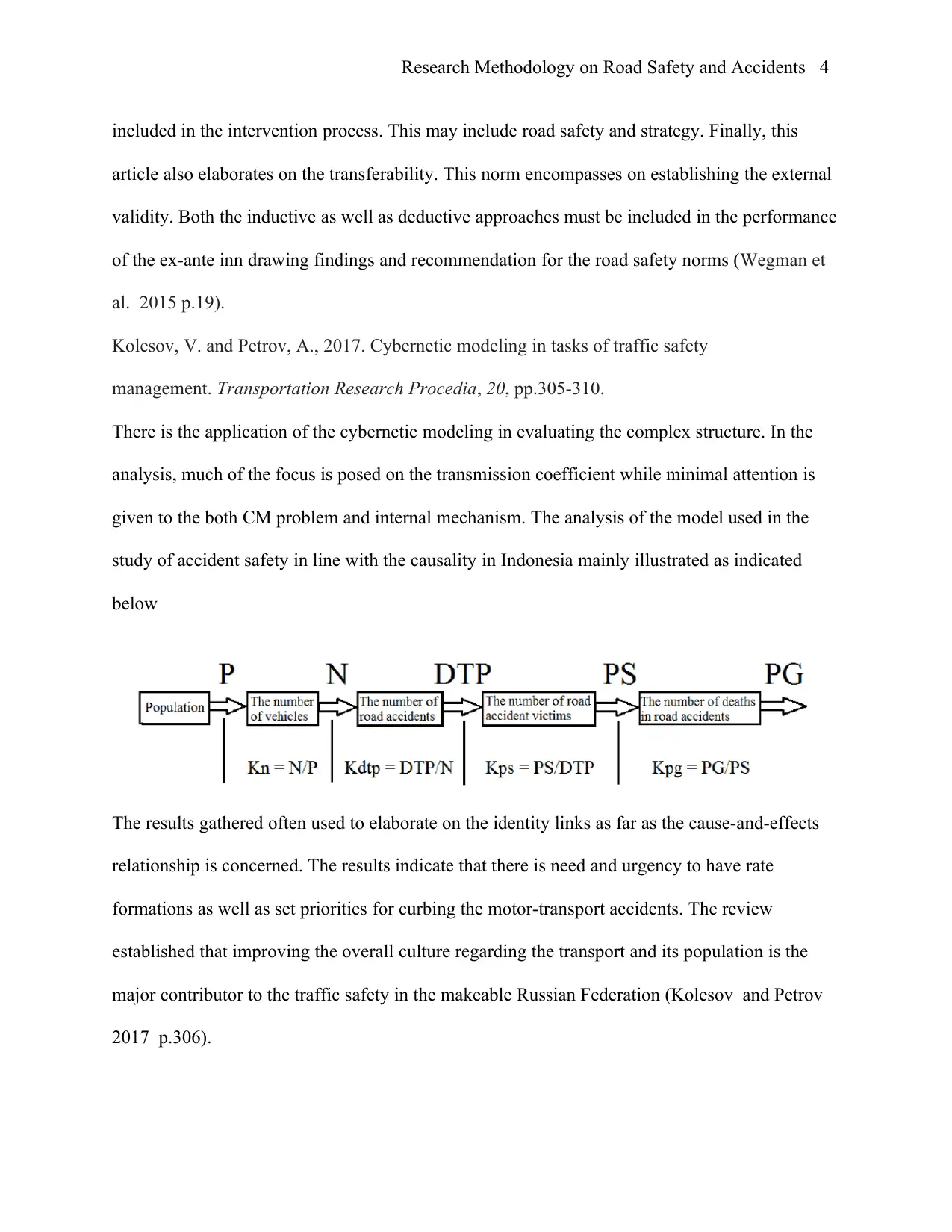
Research Methodology on Road Safety and Accidents 4
included in the intervention process. This may include road safety and strategy. Finally, this
article also elaborates on the transferability. This norm encompasses on establishing the external
validity. Both the inductive as well as deductive approaches must be included in the performance
of the ex-ante inn drawing findings and recommendation for the road safety norms (Wegman et
al. 2015 p.19).
Kolesov, V. and Petrov, A., 2017. Cybernetic modeling in tasks of traffic safety
management. Transportation Research Procedia, 20, pp.305-310.
There is the application of the cybernetic modeling in evaluating the complex structure. In the
analysis, much of the focus is posed on the transmission coefficient while minimal attention is
given to the both CM problem and internal mechanism. The analysis of the model used in the
study of accident safety in line with the causality in Indonesia mainly illustrated as indicated
below
The results gathered often used to elaborate on the identity links as far as the cause-and-effects
relationship is concerned. The results indicate that there is need and urgency to have rate
formations as well as set priorities for curbing the motor-transport accidents. The review
established that improving the overall culture regarding the transport and its population is the
major contributor to the traffic safety in the makeable Russian Federation (Kolesov and Petrov
2017 p.306).
included in the intervention process. This may include road safety and strategy. Finally, this
article also elaborates on the transferability. This norm encompasses on establishing the external
validity. Both the inductive as well as deductive approaches must be included in the performance
of the ex-ante inn drawing findings and recommendation for the road safety norms (Wegman et
al. 2015 p.19).
Kolesov, V. and Petrov, A., 2017. Cybernetic modeling in tasks of traffic safety
management. Transportation Research Procedia, 20, pp.305-310.
There is the application of the cybernetic modeling in evaluating the complex structure. In the
analysis, much of the focus is posed on the transmission coefficient while minimal attention is
given to the both CM problem and internal mechanism. The analysis of the model used in the
study of accident safety in line with the causality in Indonesia mainly illustrated as indicated
below
The results gathered often used to elaborate on the identity links as far as the cause-and-effects
relationship is concerned. The results indicate that there is need and urgency to have rate
formations as well as set priorities for curbing the motor-transport accidents. The review
established that improving the overall culture regarding the transport and its population is the
major contributor to the traffic safety in the makeable Russian Federation (Kolesov and Petrov
2017 p.306).
Paraphrase This Document
Need a fresh take? Get an instant paraphrase of this document with our AI Paraphraser
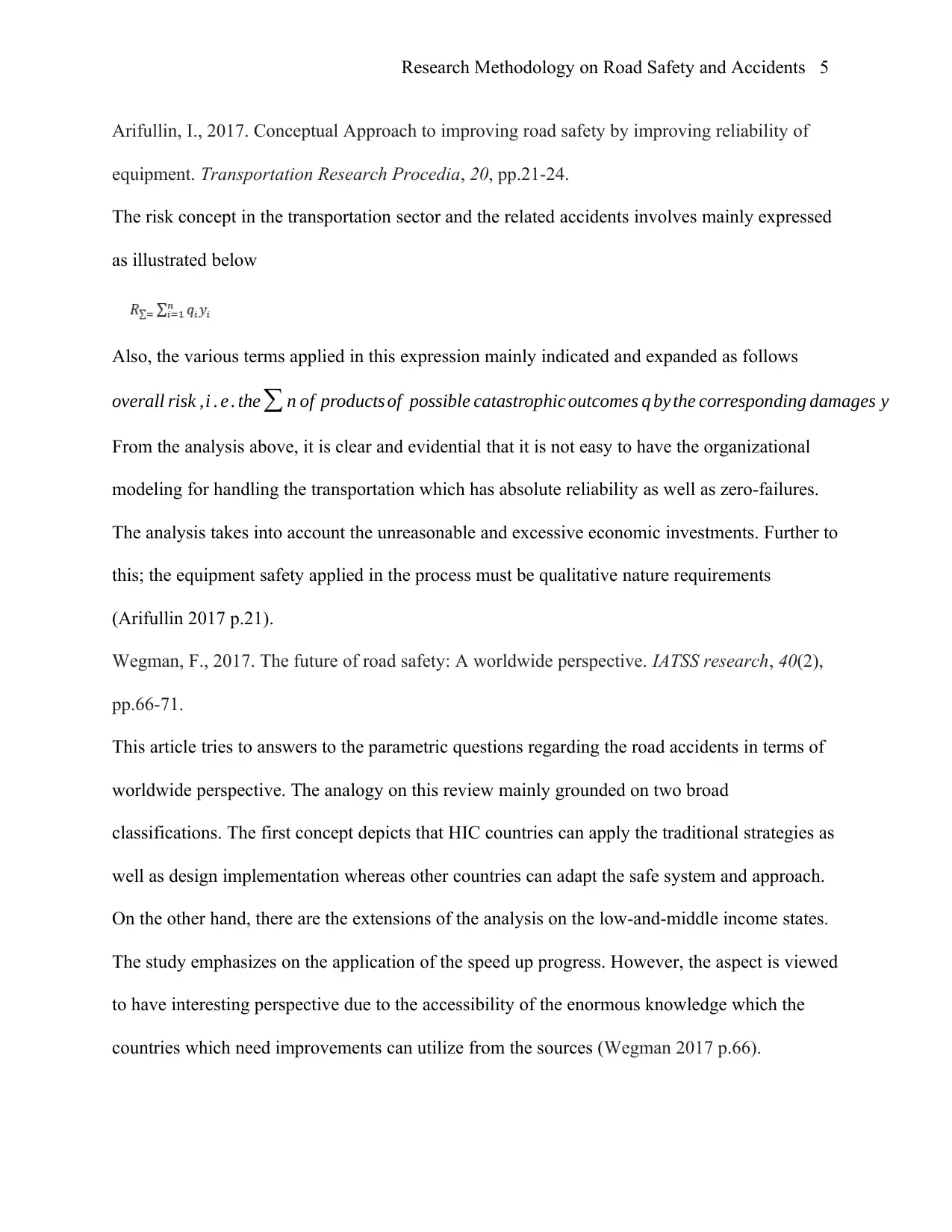
Research Methodology on Road Safety and Accidents 5
Arifullin, I., 2017. Conceptual Approach to improving road safety by improving reliability of
equipment. Transportation Research Procedia, 20, pp.21-24.
The risk concept in the transportation sector and the related accidents involves mainly expressed
as illustrated below
Also, the various terms applied in this expression mainly indicated and expanded as follows
overall risk ,i . e . the∑ n of products of possible catastrophic outcomes q by the corresponding damages y
From the analysis above, it is clear and evidential that it is not easy to have the organizational
modeling for handling the transportation which has absolute reliability as well as zero-failures.
The analysis takes into account the unreasonable and excessive economic investments. Further to
this; the equipment safety applied in the process must be qualitative nature requirements
(Arifullin 2017 p.21).
Wegman, F., 2017. The future of road safety: A worldwide perspective. IATSS research, 40(2),
pp.66-71.
This article tries to answers to the parametric questions regarding the road accidents in terms of
worldwide perspective. The analogy on this review mainly grounded on two broad
classifications. The first concept depicts that HIC countries can apply the traditional strategies as
well as design implementation whereas other countries can adapt the safe system and approach.
On the other hand, there are the extensions of the analysis on the low-and-middle income states.
The study emphasizes on the application of the speed up progress. However, the aspect is viewed
to have interesting perspective due to the accessibility of the enormous knowledge which the
countries which need improvements can utilize from the sources (Wegman 2017 p.66).
Arifullin, I., 2017. Conceptual Approach to improving road safety by improving reliability of
equipment. Transportation Research Procedia, 20, pp.21-24.
The risk concept in the transportation sector and the related accidents involves mainly expressed
as illustrated below
Also, the various terms applied in this expression mainly indicated and expanded as follows
overall risk ,i . e . the∑ n of products of possible catastrophic outcomes q by the corresponding damages y
From the analysis above, it is clear and evidential that it is not easy to have the organizational
modeling for handling the transportation which has absolute reliability as well as zero-failures.
The analysis takes into account the unreasonable and excessive economic investments. Further to
this; the equipment safety applied in the process must be qualitative nature requirements
(Arifullin 2017 p.21).
Wegman, F., 2017. The future of road safety: A worldwide perspective. IATSS research, 40(2),
pp.66-71.
This article tries to answers to the parametric questions regarding the road accidents in terms of
worldwide perspective. The analogy on this review mainly grounded on two broad
classifications. The first concept depicts that HIC countries can apply the traditional strategies as
well as design implementation whereas other countries can adapt the safe system and approach.
On the other hand, there are the extensions of the analysis on the low-and-middle income states.
The study emphasizes on the application of the speed up progress. However, the aspect is viewed
to have interesting perspective due to the accessibility of the enormous knowledge which the
countries which need improvements can utilize from the sources (Wegman 2017 p.66).
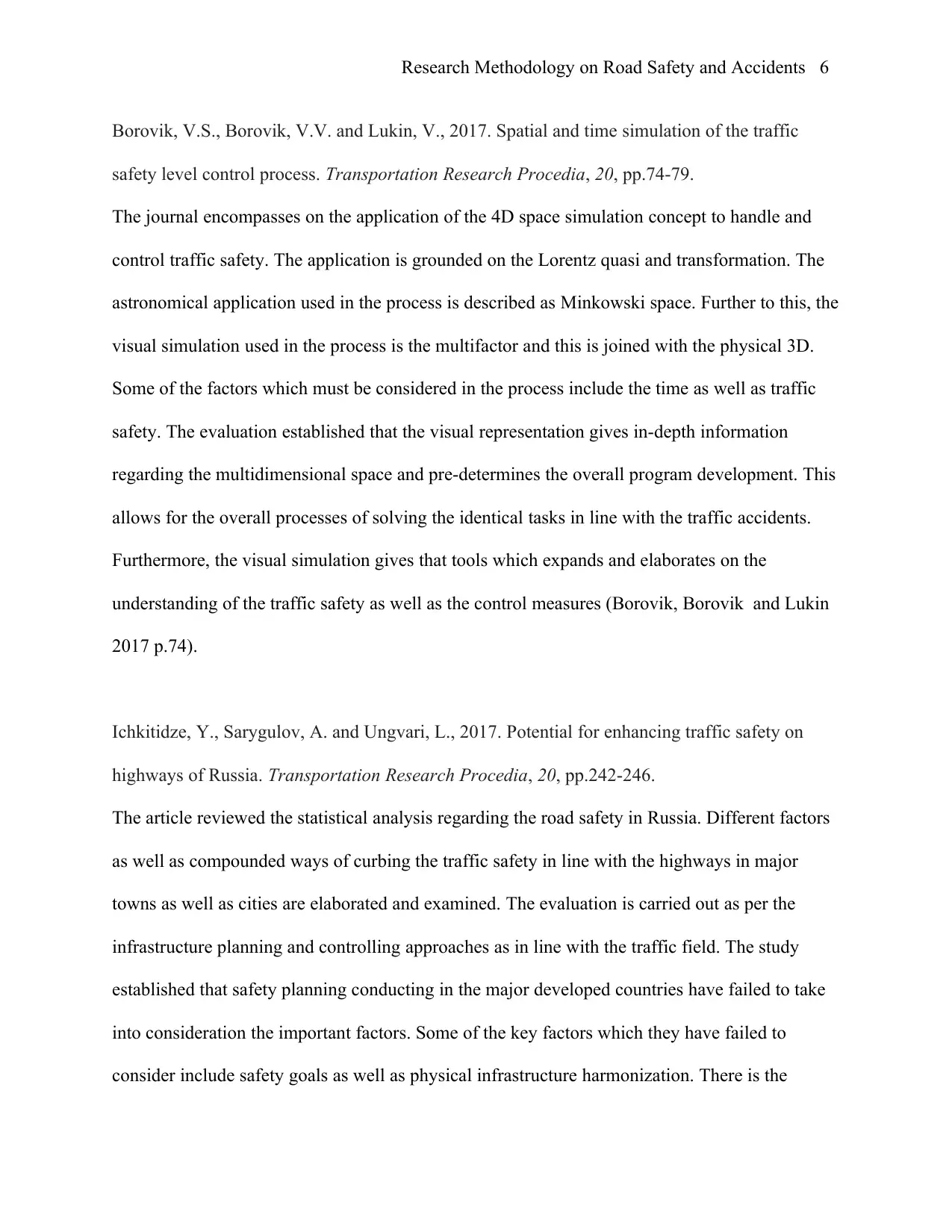
Research Methodology on Road Safety and Accidents 6
Borovik, V.S., Borovik, V.V. and Lukin, V., 2017. Spatial and time simulation of the traffic
safety level control process. Transportation Research Procedia, 20, pp.74-79.
The journal encompasses on the application of the 4D space simulation concept to handle and
control traffic safety. The application is grounded on the Lorentz quasi and transformation. The
astronomical application used in the process is described as Minkowski space. Further to this, the
visual simulation used in the process is the multifactor and this is joined with the physical 3D.
Some of the factors which must be considered in the process include the time as well as traffic
safety. The evaluation established that the visual representation gives in-depth information
regarding the multidimensional space and pre-determines the overall program development. This
allows for the overall processes of solving the identical tasks in line with the traffic accidents.
Furthermore, the visual simulation gives that tools which expands and elaborates on the
understanding of the traffic safety as well as the control measures (Borovik, Borovik and Lukin
2017 p.74).
Ichkitidze, Y., Sarygulov, A. and Ungvari, L., 2017. Potential for enhancing traffic safety on
highways of Russia. Transportation Research Procedia, 20, pp.242-246.
The article reviewed the statistical analysis regarding the road safety in Russia. Different factors
as well as compounded ways of curbing the traffic safety in line with the highways in major
towns as well as cities are elaborated and examined. The evaluation is carried out as per the
infrastructure planning and controlling approaches as in line with the traffic field. The study
established that safety planning conducting in the major developed countries have failed to take
into consideration the important factors. Some of the key factors which they have failed to
consider include safety goals as well as physical infrastructure harmonization. There is the
Borovik, V.S., Borovik, V.V. and Lukin, V., 2017. Spatial and time simulation of the traffic
safety level control process. Transportation Research Procedia, 20, pp.74-79.
The journal encompasses on the application of the 4D space simulation concept to handle and
control traffic safety. The application is grounded on the Lorentz quasi and transformation. The
astronomical application used in the process is described as Minkowski space. Further to this, the
visual simulation used in the process is the multifactor and this is joined with the physical 3D.
Some of the factors which must be considered in the process include the time as well as traffic
safety. The evaluation established that the visual representation gives in-depth information
regarding the multidimensional space and pre-determines the overall program development. This
allows for the overall processes of solving the identical tasks in line with the traffic accidents.
Furthermore, the visual simulation gives that tools which expands and elaborates on the
understanding of the traffic safety as well as the control measures (Borovik, Borovik and Lukin
2017 p.74).
Ichkitidze, Y., Sarygulov, A. and Ungvari, L., 2017. Potential for enhancing traffic safety on
highways of Russia. Transportation Research Procedia, 20, pp.242-246.
The article reviewed the statistical analysis regarding the road safety in Russia. Different factors
as well as compounded ways of curbing the traffic safety in line with the highways in major
towns as well as cities are elaborated and examined. The evaluation is carried out as per the
infrastructure planning and controlling approaches as in line with the traffic field. The study
established that safety planning conducting in the major developed countries have failed to take
into consideration the important factors. Some of the key factors which they have failed to
consider include safety goals as well as physical infrastructure harmonization. There is the
⊘ This is a preview!⊘
Do you want full access?
Subscribe today to unlock all pages.

Trusted by 1+ million students worldwide
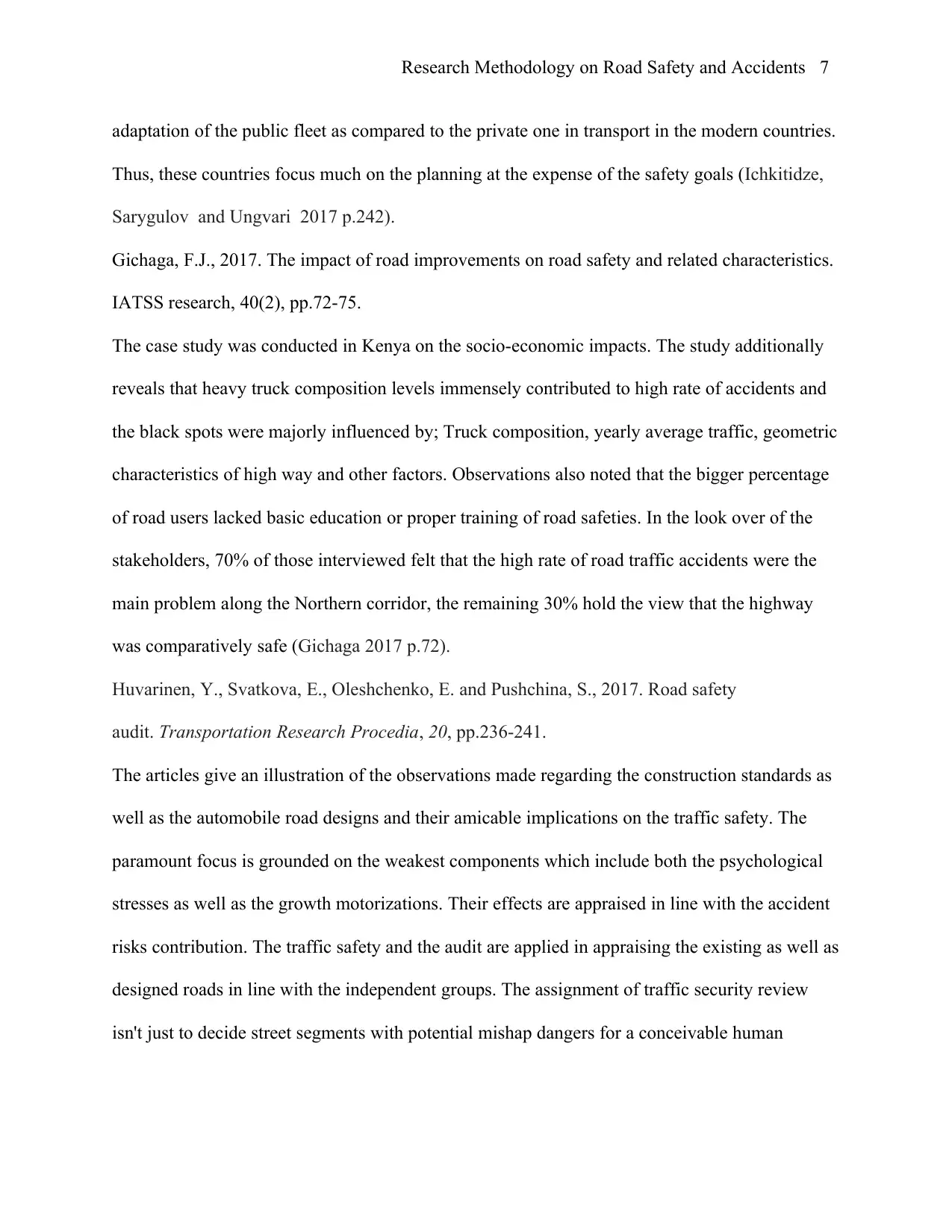
Research Methodology on Road Safety and Accidents 7
adaptation of the public fleet as compared to the private one in transport in the modern countries.
Thus, these countries focus much on the planning at the expense of the safety goals (Ichkitidze,
Sarygulov and Ungvari 2017 p.242).
Gichaga, F.J., 2017. The impact of road improvements on road safety and related characteristics.
IATSS research, 40(2), pp.72-75.
The case study was conducted in Kenya on the socio-economic impacts. The study additionally
reveals that heavy truck composition levels immensely contributed to high rate of accidents and
the black spots were majorly influenced by; Truck composition, yearly average traffic, geometric
characteristics of high way and other factors. Observations also noted that the bigger percentage
of road users lacked basic education or proper training of road safeties. In the look over of the
stakeholders, 70% of those interviewed felt that the high rate of road traffic accidents were the
main problem along the Northern corridor, the remaining 30% hold the view that the highway
was comparatively safe (Gichaga 2017 p.72).
Huvarinen, Y., Svatkova, E., Oleshchenko, E. and Pushchina, S., 2017. Road safety
audit. Transportation Research Procedia, 20, pp.236-241.
The articles give an illustration of the observations made regarding the construction standards as
well as the automobile road designs and their amicable implications on the traffic safety. The
paramount focus is grounded on the weakest components which include both the psychological
stresses as well as the growth motorizations. Their effects are appraised in line with the accident
risks contribution. The traffic safety and the audit are applied in appraising the existing as well as
designed roads in line with the independent groups. The assignment of traffic security review
isn't just to decide street segments with potential mishap dangers for a conceivable human
adaptation of the public fleet as compared to the private one in transport in the modern countries.
Thus, these countries focus much on the planning at the expense of the safety goals (Ichkitidze,
Sarygulov and Ungvari 2017 p.242).
Gichaga, F.J., 2017. The impact of road improvements on road safety and related characteristics.
IATSS research, 40(2), pp.72-75.
The case study was conducted in Kenya on the socio-economic impacts. The study additionally
reveals that heavy truck composition levels immensely contributed to high rate of accidents and
the black spots were majorly influenced by; Truck composition, yearly average traffic, geometric
characteristics of high way and other factors. Observations also noted that the bigger percentage
of road users lacked basic education or proper training of road safeties. In the look over of the
stakeholders, 70% of those interviewed felt that the high rate of road traffic accidents were the
main problem along the Northern corridor, the remaining 30% hold the view that the highway
was comparatively safe (Gichaga 2017 p.72).
Huvarinen, Y., Svatkova, E., Oleshchenko, E. and Pushchina, S., 2017. Road safety
audit. Transportation Research Procedia, 20, pp.236-241.
The articles give an illustration of the observations made regarding the construction standards as
well as the automobile road designs and their amicable implications on the traffic safety. The
paramount focus is grounded on the weakest components which include both the psychological
stresses as well as the growth motorizations. Their effects are appraised in line with the accident
risks contribution. The traffic safety and the audit are applied in appraising the existing as well as
designed roads in line with the independent groups. The assignment of traffic security review
isn't just to decide street segments with potential mishap dangers for a conceivable human
Paraphrase This Document
Need a fresh take? Get an instant paraphrase of this document with our AI Paraphraser

Research Methodology on Road Safety and Accidents 8
mistake yet in addition to get ready proposals for end of such dangers before mishaps happen at
these areas (Huvarinen, Svatkova, Oleshchenko and Pushchina 2017 p.236).
mistake yet in addition to get ready proposals for end of such dangers before mishaps happen at
these areas (Huvarinen, Svatkova, Oleshchenko and Pushchina 2017 p.236).
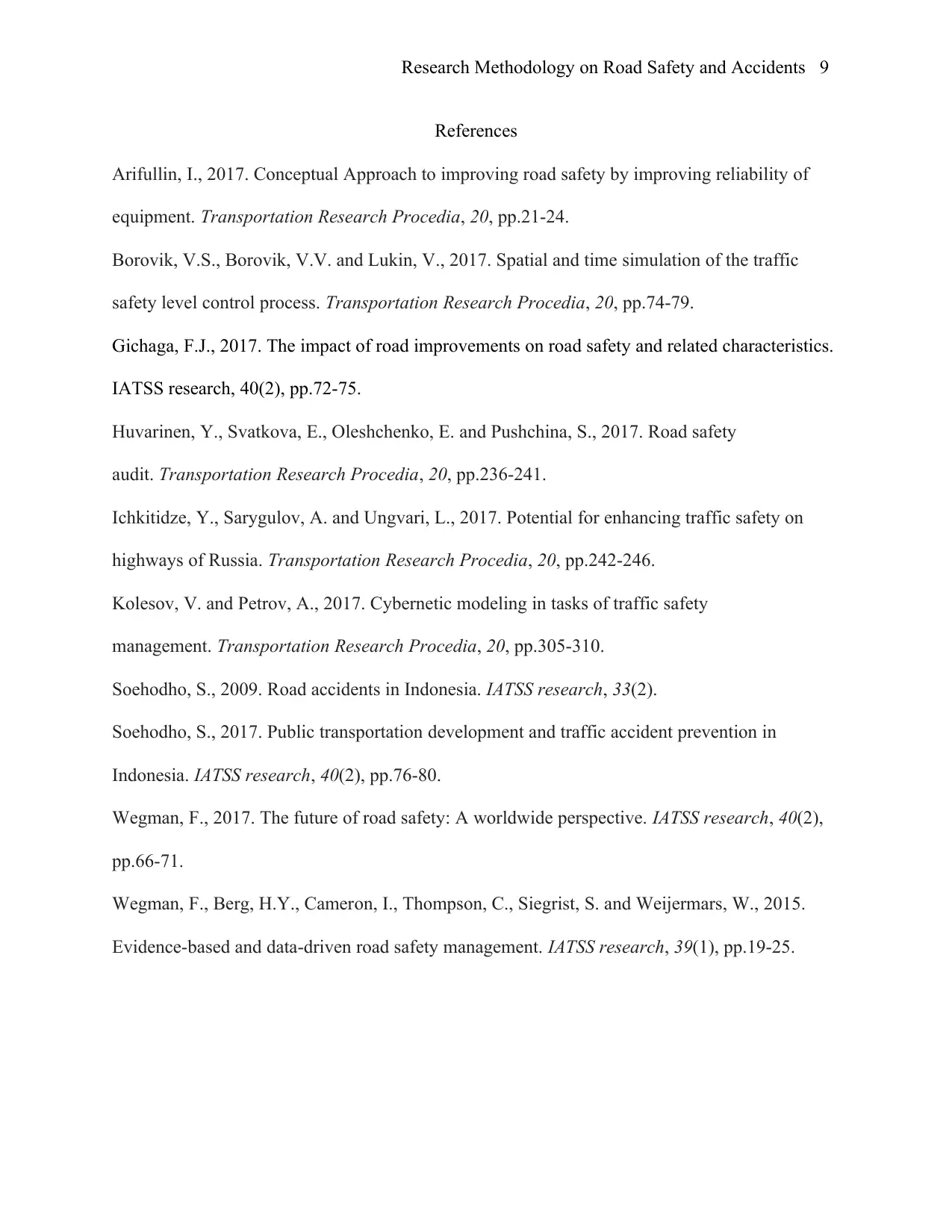
Research Methodology on Road Safety and Accidents 9
References
Arifullin, I., 2017. Conceptual Approach to improving road safety by improving reliability of
equipment. Transportation Research Procedia, 20, pp.21-24.
Borovik, V.S., Borovik, V.V. and Lukin, V., 2017. Spatial and time simulation of the traffic
safety level control process. Transportation Research Procedia, 20, pp.74-79.
Gichaga, F.J., 2017. The impact of road improvements on road safety and related characteristics.
IATSS research, 40(2), pp.72-75.
Huvarinen, Y., Svatkova, E., Oleshchenko, E. and Pushchina, S., 2017. Road safety
audit. Transportation Research Procedia, 20, pp.236-241.
Ichkitidze, Y., Sarygulov, A. and Ungvari, L., 2017. Potential for enhancing traffic safety on
highways of Russia. Transportation Research Procedia, 20, pp.242-246.
Kolesov, V. and Petrov, A., 2017. Cybernetic modeling in tasks of traffic safety
management. Transportation Research Procedia, 20, pp.305-310.
Soehodho, S., 2009. Road accidents in Indonesia. IATSS research, 33(2).
Soehodho, S., 2017. Public transportation development and traffic accident prevention in
Indonesia. IATSS research, 40(2), pp.76-80.
Wegman, F., 2017. The future of road safety: A worldwide perspective. IATSS research, 40(2),
pp.66-71.
Wegman, F., Berg, H.Y., Cameron, I., Thompson, C., Siegrist, S. and Weijermars, W., 2015.
Evidence-based and data-driven road safety management. IATSS research, 39(1), pp.19-25.
References
Arifullin, I., 2017. Conceptual Approach to improving road safety by improving reliability of
equipment. Transportation Research Procedia, 20, pp.21-24.
Borovik, V.S., Borovik, V.V. and Lukin, V., 2017. Spatial and time simulation of the traffic
safety level control process. Transportation Research Procedia, 20, pp.74-79.
Gichaga, F.J., 2017. The impact of road improvements on road safety and related characteristics.
IATSS research, 40(2), pp.72-75.
Huvarinen, Y., Svatkova, E., Oleshchenko, E. and Pushchina, S., 2017. Road safety
audit. Transportation Research Procedia, 20, pp.236-241.
Ichkitidze, Y., Sarygulov, A. and Ungvari, L., 2017. Potential for enhancing traffic safety on
highways of Russia. Transportation Research Procedia, 20, pp.242-246.
Kolesov, V. and Petrov, A., 2017. Cybernetic modeling in tasks of traffic safety
management. Transportation Research Procedia, 20, pp.305-310.
Soehodho, S., 2009. Road accidents in Indonesia. IATSS research, 33(2).
Soehodho, S., 2017. Public transportation development and traffic accident prevention in
Indonesia. IATSS research, 40(2), pp.76-80.
Wegman, F., 2017. The future of road safety: A worldwide perspective. IATSS research, 40(2),
pp.66-71.
Wegman, F., Berg, H.Y., Cameron, I., Thompson, C., Siegrist, S. and Weijermars, W., 2015.
Evidence-based and data-driven road safety management. IATSS research, 39(1), pp.19-25.
⊘ This is a preview!⊘
Do you want full access?
Subscribe today to unlock all pages.

Trusted by 1+ million students worldwide
1 out of 9
Your All-in-One AI-Powered Toolkit for Academic Success.
+13062052269
info@desklib.com
Available 24*7 on WhatsApp / Email
![[object Object]](/_next/static/media/star-bottom.7253800d.svg)
Unlock your academic potential
Copyright © 2020–2025 A2Z Services. All Rights Reserved. Developed and managed by ZUCOL.


